The Enduring Appeal of 70s Scarves in Fashion
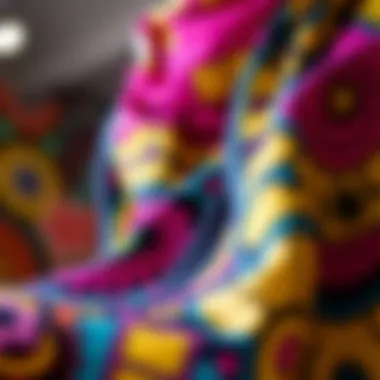
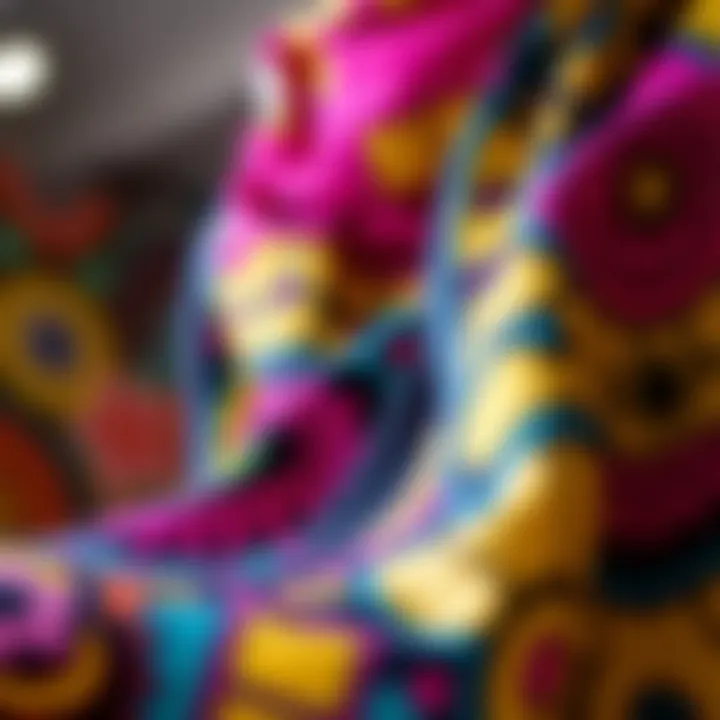
Intro
The scarf, often overlooked as merely an accessory, carries a depth that transcends its fabric. In the 1970s, this piece of cloth transformed into a symbol of self-expression and artistic flair. Capturing the essence of an era marked by vibrant change and cultural revolutions, the 70s scarf emerged as a cornerstone of style. From the bohemian free spirits to the chic urbanites, this accessory was a versatile companion, evolving to reflect the disparate vibes of the decade.
As we take this journey through the historical alleyways of fashion, we will unpack how the 70s scarf was much more than a fashion statement. It was a canvas upon which individuals painted their identities, aspirations, and the zeitgeist of the time. We will delve into its origins, the various fabrics that shaped its identity, and how it continues to influence contemporary wardrobe choices. The timeless allure of this multifaceted accessory invites us to explore its relevance now, as it finds its way back into the spotlight of modern fashion.
Arming ourselves with knowledge and insight, we can better appreciate the rich history of the 70s scarf and discover practical ways to weave it into our current styles.
Tracing the Historical Context of the 70s Scarf
Underpinning the aesthetic and practical appeal of the 70s scarf is a rich historical context that intertwines with various cultural, social, and fashion movements of the time. Understanding this context not only enriches our appreciation of the scarf itself but also highlights its evolution through a decade marked by change and innovation. The scarf serves as a quintessential piece reflecting broader themes such as individuality, rebellion, and the merging of fashion with personal expression. By exploring its roots, we can see how this accessory transcended mere utility to become a symbol of the era's diverse styles and ideologies.
The Cultural Landscape of the 1970s
The 1970s were characterized by a cultural landscape ripe with dynamism and contrasts. The era was marked by the echoes of the counterculture movements that emerged in the late 1960s, amidst the backdrop of political unrest, civil rights movements, and an awakening to environmental consciousness. Fashion, in particular, became a canvas where individuals voiced their sentiments, strong beliefs, and aspirations.
During this transformative decade, the media played a crucial role in shaping societal views. Movies and music brought icons to the forefront, from rock stars to political activists. The likes of Janis Joplin and David Bowie, with their eclectic styles and charismatic personas, influenced fashion choices, proving that self-expression could be bold and limitless. Scarves, often draped carelessly around necks or tied in unique knots, became an integral part of this narrative, symbolizing a break from tradition as individuals carved out their identities.
Moreover, the growing acceptance and celebration of bohemian and avant-garde styles made the scarf a staple accessory reflecting individuality. Its versatility allowed for experimentation, aligned perfectly with the decade's ethos of freedom and exploration.
Key Fashion Movements Influencing Scarf Design
Fashion in the 1970s was far from monolithic, as it was shaped by a multitude of movements spanning various subcultures. From the hippie trend that embraced natural fibers and ethnic prints to the glam rock movement which pushed boundaries with glitter and leather, scarves adapted to these shifting tides.
- Hippie Fashion:
- Punk Rock:
- Disco Influence:
- This movement brought about a love for vibrant colors and paisley prints, where scarves often featured elaborate designs inspired by Eastern aesthetics. Scarves were worn as headbands or tied onto bags, often adorned with fringes, embracing a laid-back, free-spirited vibe.
- In stark contrast, the punk scene introduced radical designs that often juxtaposed elegance with rebellion. Scarves in this sphere might have been made from leather or synthetic materials, featuring bold graphics or slogans that made striking statements.
- Disco’s glitzy nightlife called for scarves made from shiny fabrics, often used to accentuate evening wear. Bright colors and metallic finishes reflected the vibrant energy of disco culture.
This interplay of various fashion movements not only enriched the design of scarves but also their significance as cultural artifacts. The ongoing evolution of scarf styles echoes the transformation of fashion itself, highlighting how accessories can encapsulate broader social narratives and personal stories.
"Fashion is like a mirror that reflects societal changes, and the 70s scarf is a testament to that interplay."
The historical context of the 70s scarf therefore serves as a ground to understand its broader implications. It invites a nuanced exploration of how fashion accessories can shape, and be shaped by, the cultural tapestry of an era.
Material Choices and Textiles: The Fabric of the Era
The essence of any fashion accessory begins with its material. In the case of the 70s scarf, the choice of textile not only reflected personal style but also conveyed social messages. Scarves during this period emerged from a multitude of fabrics, showcasing a vibrant interplay of functionality and aesthetic appeal. With the rise of the counterculture movement, the materials selected for scarves became a canvas for expressing artistic and political sentiments.
Scarves were more than mere fabric; they were symbols—oftentimes worn as a badge of identity in a transformative decade. Understanding the materials used in 70s scarves is crucial, as it reveals the intricate relationship between fabric, form, and fashion.
Popular Fabrics Used in 70s Scarves
In the 1970s, a variety of fabrics contributed to the signature look of scarves. Here are some of the leading contenders:
- Silk: Embraced for its luxurious texture and vibrant lustre, silk scarves were often adorned with intricate designs. The lightweight nature of silk offered versatility, making it a favorite among fashion enthusiasts for both casual and formal occasions.
- Cotton: A staple in everyday wear, cotton scarves were celebrated for their comfort and breathability. This fabric enabled bold prints and allowed for easy care, aligning perfectly with the busy lifestyles of the era.
- Wool: During the cooler months, wool scarves became essential staples. The warmth provided by these fabrics ensured that they were not only stylish but practical as well.
- Synthetic Blends: As technology advanced, synthetic fibers gained traction. These fabrics allowed for more vivid colors and patterns that would stand the test of time—characteristic elements that defined 70s fashion.
"Fabric choice is about more than aesthetics; it's about identity, culture, and the stories we choose to tell through fashion."
The Role of Prints and Patterns
The impact of prints and patterns on 70s scarves cannot be overstated. They acted as visual narratives—a way of speaking when words fell short. The decade was marked by a kaleidoscope of designs, from vibrant florals to abstract geometric prints.
The patterns often reflected broader design movements influencing the fashion landscape. For instance:
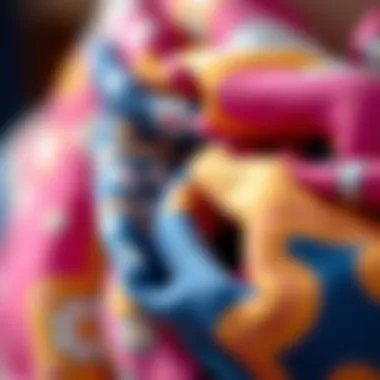
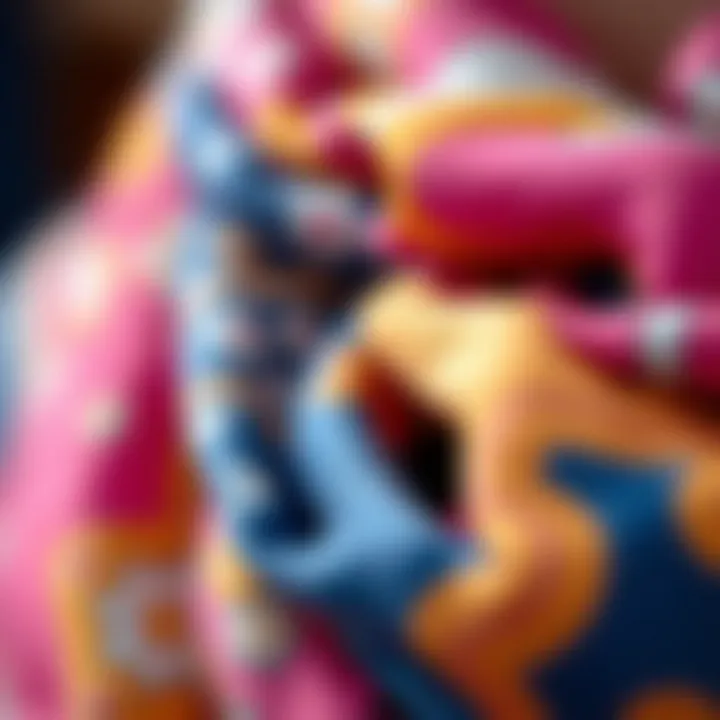
- Paisley: With its teardrop shapes and intricate motifs, paisley flourished throughout this period, symbolizing both the eclectic spirit of the 70s and a nod to vintage inspiration.
- Floral Prints: A celebration of nature, floral patterns mirrored the increasingly popular bohemian lifestyle, signifying a newfound freedom and connection to the earth.
- Geometric Designs: Bold, graphic prints proliferated, resonating with the cutting-edge art movements like Op Art and Minimalism, representing a shift toward simplicity and modernity.
Each of these patterns brought a unique vibrancy and a visual language that allowed wearers to embody their beliefs and aesthetics in ways that transcended traditional fashion norms. Today, understanding the diverse fabric choices and patterns of the 70s scarf enables designers and stylists to reinterpret and reconnect with the enduring legacy of this iconic accessory amidst contemporary trends.
Iconic Styles and Patterns of the 70s Scarf
The significance of the 70s scarf lies not only in its ability to elevate an outfit but also in its representation of the broader cultural and artistic movements of that decade. This section delves into the most iconic styles and patterns that defined 70s scarves, focusing on their aesthetic dimensions and how they resonated with fashion trends of the time. Understanding these styles provides valuable insight into the intersection of fashion and culture during a transformative era.
Paisley and Bohemian Influences
The paisley pattern, with its teardrop shapes and swirling designs, became synonymous with the bohemian lifestyle that thrived during the 1970s. Originating from Persian designs, paisley found its way into Western fashion, becoming a staple in scarves, blouses, and accessories. The application of paisley in scarves allowed wearers to express their individuality while also tapping into the era's love for free-spirited, artisanal aesthetics.
Worn by music icons and influencers, paisley scarves often featured rich color palettes—think deep greens, spicy oranges, and earthy browns. Combined with flowing fabrics, these scarves represented not just a style choice but a statement of rebellion against mainstream fashion. Wearing a paisley scarf could send a message of artistic expression and a nod to the counterculture movement.
This pattern's charm lies in its adaptability; whether wrapped around the neck, used as a headband, or tied to a bag, the paisley scarf has shown remarkable versatility. For those looking to recreate or integrate this iconic style in contemporary wardrobes, it’s imperative to consider how best to highlight its intricate designs while pairing it with modern pieces. Understanding how to balance prints with solid colors can enhance the paisley motif’s impact without overwhelming an outfit.
Geometric Designs and Their Appeal
Shifting away from organic patterns, geometric designs gained traction in the 70s, reflecting the era's fascination with structure and boldness. Scarves featuring triangular, square, and circular motifs became popular, often in stark contrasts or vibrant colors that grabbed attention. The geometric appeal lied in its graphical nature, providing a fresh take on accessorizing amid the softness of floral and paisley options.
Designers like André Courrèges and Yves Saint Laurent embraced geometric patterns, showcasing them in luxurious fabrics. Their influences transcended mere decoration; they evoked a sense of futurism and modernity, aligning with the technological advances and cultural shifts of the time. Scarves with geometric designs could easily be styled to create visual intrigue, whether draped over the shoulders or worn as a belt.
Integrating geometric scarves into today's fashion requires a keen eye for balance. Pairing these eye-catching patterns with minimalist outfits allows the scarf to take center stage, serving as a conversation starter. Those who appreciate the boldness of geometric designs often find joy in layering them with various textures to create a visually dynamic ensemble.
The iconic styles of the 70s scarf, be it paisley or geometric, allowed for profound self-expression and showcased the ever-evolving narrative of fashion.
Fashion Icons and Their Impact on Scarf Trends
The significance of fashion icons in shaping scarf trends during the 1970s cannot be overstated. These personalities didn't just wear scarves; they transformed them into symbols of status, style, and individual expression. As a cornerstone of women's fashion in this dynamic decade, scarves took on roles beyond mere accessories, becoming essential components of a fully orchestrated look. Their influence reverberates through today’s fashion landscape, reminding us how past icons have paved the way for innovations in scarf styling.
Celebrities Who Redefined Scarf Usage
In the realm of celebrity fashion, a few names ring bells of nostalgia more than others. Think of Jacqueline Kennedy Onassis gliding through the streets of New York, a silk scarf casually knotted around her neck, effortlessly exuding sophistication. Her choice of scarves often juxtaposed bold colors with delicate patterns, setting a standard for elegance.
Then there’s the emblematic style of Diana Ross. With her voluminous hair and striking outfits, she often adorned herself with scarves that complemented her bohemian aesthetic. These pieces—in various hues and fabrics—were not merely functional; they served as visual punctuation that defined her style. Whether worn in a dramatic knot or merely draped over a shoulder, Ross's interpretation of the scarf was emblematic of an era that celebrated freedom and self-expression.
More contemporary figures, like Freddie Mercury, took a different approach. With his penchant for flamboyant and bold fashion choices, he would tie scarves around his neck and often use them as a prop during performances, making them an inseparable part of his on-stage persona. This blend of functionality and performance art redefined the way scarves were perceived in the music world and beyond.
The use of scarves by these celebrities lent to a broader cultural conversation surrounding identity, femininity, and self-assertion. Scarves became incontrovertibly linked to the larger narrative of the 70s—an element of personal narrative and an invitation for women to experiment with their looks. Celebrities didn’t just wear scarves; they made statements and challenged norms. This evolution of thought around fashion pieces continues to spark new ideas for modern wardrobes.
Influential Designers of the 70s
Fashion designers from the 70s played a crucial part in elevating scarves from mere accessories to fashion statements. Names like Yves Saint Laurent and Halston stand out prominently. Their work captured the zeitgeist of a generation, blending high fashion with everyday wear.
Yves Saint Laurent’s designs, often characterized by sharp lines and bold patterns, inspired a revolution in how scarves were worn. The Le Smoking tuxedo jacket, for instance, encouraged women to incorporate scarves into more traditionally male-dominated styles, further merging gender boundaries in fashion.
Halston, known for his chic and luxurious designs, embraced the fluidity of fabric and the versatility of scarves, using them to enhance his draped silhouettes. His runway shows included models who wore scarves in ways unimagined before, such as in their hair or as belts, showcasing the endless possibilities that a simple piece of fabric could embody.
These designers understood that a scarf could do more than just keep someone warm; they realized it could encapsulate elegance, attitude, and style all at once. The enduring legacy of these trends speaks volumes about the adaptability of the scarf, making it an essential item in the fashion lexicon. Designers of that era pushed the boundaries of what it meant to accessorize, leaving an indelible mark on how future generations perceive and wear scarves.
As we delve deeper into the discussion of scarves, it's essential to recognize the lasting impressions left by these icons and designers. Their legacies invite modern stylists and consumers to re-examine and reinvigorate the role of the scarf in contemporary wardrobes—one that continues to evolve, yet remains anchored in rich historical context.
The Versatility of the 70s Scarf in Wardrobe Styling
The 70s scarf holds a special place in the realm of fashion, and its versatility stands out as a key element that defines its enduring allure. This accessory is not simply an ornament; it’s an essential tool for expression. Scarves can transform an outfit, adding depth and dimension while underscoring personal style. Whether you're dressing for casual outings or more formal events, integrating a 70s scarf can elevate your look.
One cannot overlook the practical benefits either. Scarves provide warmth and comfort, making them useful in various climates. They also serve as an easy way to incorporate color and pattern into any outfit. As such, knowing how to best utilize this all-in-one piece can enhance your wardrobe considerably, making it a staple rather than just an afterthought.
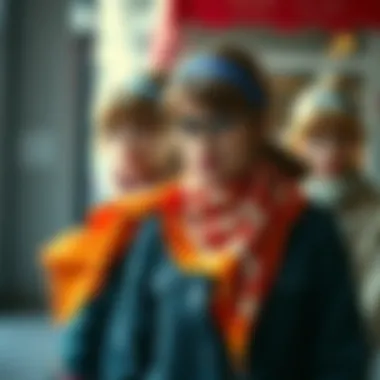
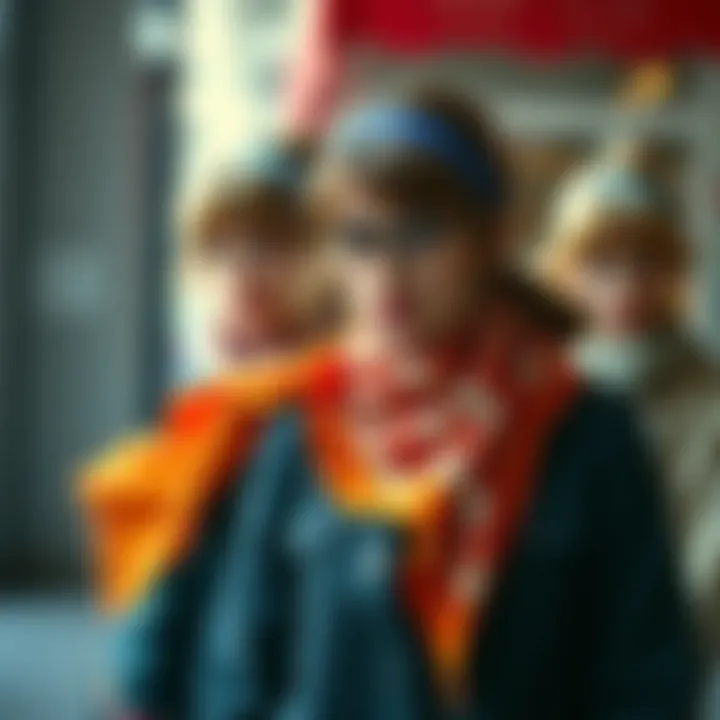
Styling Options for Different Occasions
Finding the right way to style a 70s scarf depends heavily on the occasion at hand. For instance:
- Casual Outings: Tying a scarf loosely around the neck, letting it drape slightly can bring a relaxed vibe to an everyday ensemble. Pairing it with a simple t-shirt, denim jacket, and well-fitted jeans works well.
- Office Wear: Scarves can add a professional touch when styled as a necktie or around the collar of a blouse. Choosing solid colors or understated prints can maintain a polished look.
- Evening Events: For formal occasions, opt for silk or chiffon scarves in rich colors and dramatic patterns. Drape the scarf over the shoulders or style it as a shawl to create an elegant silhouette.
- Bohemian Looks: Embrace the full spirit of the 70s with oversized scarves worn as a headband or turban. Coupling this with flowing fabrics and earthy colors can truly capture the essence of the decade.
Keeping these different contexts in mind allows for a greater range of styling possibilities. The 70s scarf is not simply an accessory; it’s a multifunctional piece that can be adjusted according to the event and mood.
How to Integrate the Scarf into Modern Fashion
As fashion evolves, so does the way we wear items from decades past. Integrating a 70s scarf into modern fashion requires a bit of creativity and awareness of current trends. Here are some effective approaches:
- Layering: Use the scarf as a layering piece. For instance, on chillier days, draping it underneath a blazer can add both warmth and texture.
- Mixing Patterns: Don't shy away from bold prints. Pairing a patterned scarf with a striped top can create a chic, modern look if done thoughtfully. It’s all about finding a balance and cohesion in your ensemble.
- Accessorizing Bags: Use a scarf tied around the handle of a handbag to add flair. This not only complements the outfit but also refreshes an old bag.
- Creative Knotting: Experiment with various knots and drapes. A simple twist or knot at the base of the neck can completely change an outfit’s dynamic.
By grasping the unique qualities of the 70s scarf and adapting them to today’s trends, individuals can create looks that are both timeless and fresh. The versatility of the 70s scarf signifies its place in today’s fashion landscape, making it a worthy addition to any wardrobe.
Scarf Tying Techniques: Historic and Contemporary Methods
The way a scarf is tied can transform an entire outfit, breathing life into an otherwise simple look. In the realm of fashion, particularly concerning the 70s scarf, tying techniques are more than just practical methods — they are expressions of style and individuality. Understanding these techniques is vital for any designer or fashion enthusiast looking to enhance their knowledge and apply historical context to contemporary fashion.
Traditional Tying Methods from the 70s
In the 1970s, scarves were often worn as bold statements, reflecting the vibrant spirit of the era. Several tying methods defined the decade, each contributing uniquely to the overall aesthetic.
- The Classic Knot: Probably the most recognizable way to wear a scarf, this method involves folding the scarf into a triangle and wrapping it around the neck, tying it at the front. It provided warmth while also being incredibly stylish.
- The Hair Tie: Scarves were not just for necks; many individuals tied them around their hair for a chic, bohemian look. This was often seen at music festivals or among free spirits who embodied the 70s counterculture.
- The Waist Wrap: Tying a scarf around the waist as a belt was another inventive way to display color and print. This method suited the flowing trousers and dresses typical of the time, enhancing covers without compromising comfort.
These techniques were celebrated not only for their functionality but also for how they allowed wearers to personalize their look.
Adapting Techniques for Modern Wear
While the classic methods from the 70s hold a place of honor in fashion history, modern interpretations and adaptations can enhance contemporary wardrobes. The key is to innovate while respecting the roots of these tying styles.
- The Infinity Loop: This modern take can be achieved by taking a long scarf and looping it around the neck twice for a look that exudes sophistication. It's practical for chilly weather and can give off an effortlessly chic vibe.
- The Neck Bow: This involves tying a scarf in a bow around the neck, making it appear polished and elegant. It has gained popularity in business casual environments and adds a touch of femininity when paired with structured tops.
- The Pocket Square: Scarves today can also function as pocket squares. Folding a scarf into a crisp triangle and placing it in a jacket pocket can make an understated yet striking statement.
When adapting these techniques, a thoughtful approach to fabric and print can help achieve a balance between the essence of the 70s scarf and contemporary aesthetics.
“Scarf tying is an art, blending history with personal expression — a way to tell your sartorial story without saying a word.”
Embracing these historic and contemporary methods ensures that the 70s scarf remains not just a nostalgic accessory, but a relevant piece in today’s fashion landscape. For designers and stylists, the ability to weave these stories into styling is invaluable.
For more inspiration on scarf designs and techniques through history, consider visiting Wikipedia and Britannica.
Sustainable Fashion: The 70s Scarf's Role Today
In a world grappling with the consequences of fast fashion, the 70s scarf has resurfaced as a symbol of sustainability. This era embraced creativity and individual expression, paralleling today's growing demand for ethical fashion choices. The timeless appeal of the scarf allows it to transcend generations, making it a perfect candidate for sustainable style.
The Resurgence of Vintage Fashion
The resurgence of vintage fashion is a fascinating aspect of today's style landscape, as more fashion-forward individuals are looking to the past for inspiration. Scarf enthusiasts are drawn to the unique patterns and stories behind each piece. This trend isn’t just about aesthetics; it’s a movement conscious of the environmental impact that comes with mass-produced garments.
Purchasing vintage scarves promotes a circular fashion model. By opting for second-hand items, consumers extend the lifecycle of garments rather than contributing to a throwaway culture. The eclectic mix of color, texture, and design from the 70s also offers a blend of nostalgia and originality that contemporary fashion often lacks.
Benefits of Resurrecting 70s Scarves
- Environmental Impact: Buying vintage reduces waste and lowers the demand for new fabric production.
- Unique Style: Each scarf tells a story, often impossible to find in today’s market.
- Cultural Significance: Wearing a piece of fashion history gives a nod to the influential styles that shaped our cultural landscape.
Ethical Material Choices for Scarves
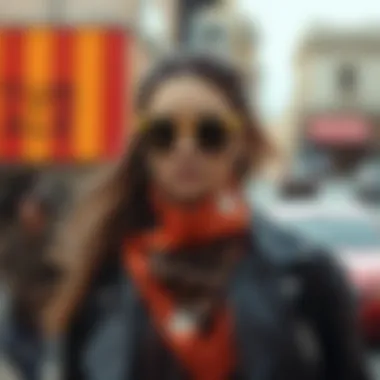

The conversation surrounding sustainable fashion isn't complete without discussing material choices. For those creating or seeking scarves today, understanding the impact of fabric production is crucial. While silk and cotton were popular in the 70s, the modern consumer has a myriad of alternatives that are both aesthetically pleasing and environmentally friendly.
Natural Fibers: Materials such as organic cotton, bamboo, and Tencel are excellent choices. These fibers are not only biodegradable but often require less water to produce compared to conventional options.
Recycled Fabrics: Scarves made from recycled materials not only reduce waste but can also provide a unique aesthetic. Brands are increasingly adopting practices that include using salvaged textiles to craft innovative designs.
"Sustainable fashion is not just about choosing the right materials; it’s about a mindset shift toward valuing quality and heritage over ephemeral trends."
As we navigate through these options, understanding where and how materials are sourced becomes vital for a truly sustainable and ethical wardrobe. Consider researching brands that prioritize ethical practices and gather information from reliable sources like Fashion Revolution or Sustainable Fashion Forum.
In closing, the 70s scarf is no longer just a relic of the past. It’s a functional piece of history that enables modern consumers to express individuality while fostering a conscientious relationship with fashion. Through the conscious choices of incorporating these scarves into contemporary wardrobes, we're not just reviving a style; we're redirecting the future of fashion towards sustainability.
The Scarf Beyond the 70s: Evolution Through the Decades
The 70s scarf stands as a significant piece within the broader evolution of fashion accessories. Its journey after the vibrant decade of the 1970s tells a tale of adaptation, resilience, and reinvention in the face of shifting cultural landscapes. Understanding this evolution is crucial, as it underscores not just the accessory's history, but also its role in contemporary wardrobes. Scarves transitioned from mere fabric to a canvas of expression, influenced by technological advancements, global cultures, and the whims of fashion leaders.
Influence of the 80s and 90s on Scarf Trends
The 1980s was a decade of excess, characterized by bold colors, oversized silhouettes, and a flair for the dramatic. Scarves became more than a functional piece; they morphed into an essential accessory that shouted personality. With the rise of pop culture icons like Madonna and Prince, the scarf was often sported in high-fashion contexts, tied in intricate ways or draped dramatically around the neck, adding a dash of glam to otherwise understated outfits.
In the 90s, a stark contrast emerged. The decade steered towards minimalism, with a focus on streamlined silhouettes. Scarves found themselves repurposed not just as neck ornaments but also as hair accessories and bag embellishments. The likes of Kate Moss and other supermodels often wrapped scarves around their heads or let them cascade from their belt loops. This era emphasized layering and combining scarves into the overall texture of an outfit, leading to innovations in how they could be worn.
- Key Trends Noted from the 80s to 90s:
- Oversized silhouettes and dramatic draping in the 1980s.
- Minimalist styling and unique usage in the 1990s.
- Scarves as functional and stylish elements in both decades.
Modern Interpretations and Innovations
As we stepped into the 21st century, innovation took the reins. Today, scarves can be found crafted from cutting-edge materials like recycled fabrics and performance textiles, reflecting a growing awareness of sustainability in fashion. Beyond traditional neck-wearing, designers are experimenting with myriad purposes for scarves, proving their versatility.
Fashion shows now display scarves used as belts, head wraps, and even tops, challenging the conventions established in earlier decades. Consider how brands like Gucci and Hermes integrate scarves into their pieces, often reviving classic prints and boasting eco-friendly production practices.
Moreover, digital platforms like Instagram have sparked creativity. Influencers and stylists share fresh ideas, promoting unconventional styled looks that breathe life into the simple square of fabric. Techniques that once were associated with crafting have evolved, resulting in unique styling methods that resonate with young audiences eager to express their individuality.
- Modern Uses of Scarves:
- Belt alternatives in high-fashion contexts.
- Hair accessories that enhance contemporary hairstyles.
- Layering pieces that add depth to fashion statements.
"The transformation of the scarf from functional necessity to artistic expression showcases fashion's ability to evolve alongside society’s tastes and values."
In summary, the evolution of the scarf beyond the 70s illustrates a remarkable journey through cultural phases and personal expression. Its adaptability demonstrates that while fashion trends may come and go, the scarf remains a timeless companion woven into the fabric of style.
The End: The Lasting Legacy of the 70s Scarf
The 70s scarf stands as more than just a piece of fabric; it is a hallmark of cultural revolutions, expressing individuality and style. Its significance extends beyond mere trends, anchoring itself in the narratives of the decades that followed. By examining its evolution, we realize how the scarf encapsulates the spirit of an era marked by political movements, artistic freedoms, and a growing appreciation for diverse aesthetics.
Historically, the 70s scarf served as a canvas, showcasing vibrant prints and textures that mirrored societal changes. This accessory has transitioned from being a mere afterthought in fashion to a centerpiece, symbolizing personal expression. As such, recognizing its legacy helps in understanding how fashion integrates with culture and identity, making it a critical study for designers, stylists, and fashion students alike.
Reflections on Historical and Cultural Significance
The historical context of the 70s scarf cannot be understated. It was during this transformative decade that scarves bloomed into the mainstream consciousness, intertwined with movements such as feminism and bohemianism. This accessory was not simply worn; it was a statement. Through its ties to notable figures like Jane Birkin, who wore her scarves in increasingly creative ways, the accessory aligned itself with a lifestyle that embraced freedom and self-expression.
Culturally, the scarf became a vehicle for communicating personal views and affiliations. Collectively, people wrapped themselves in fabrics that resonated with their beliefs and aspirations. From paisleys to geometrics, the patterns reflected a global tapestry, absorbing inspirations from various cultures. The intimacy of a scarf, its ability to be tied in numerous styles, allowed it to act as a bridge between different communities. As a result, these scarves transcended fashion, acting as a social commentary on the values and ideals of the time.
The Scarf's Place in Future Fashion Narratives
Fast forward to today, and the 70s scarf continues to occupy a unique space within fashion narratives. Its adaptability means that it can hold its ground amid shifting trends. As we look toward the future, the scarf remains a practical accessory that merges with modern sensibilities and sustainable fashion practices. Designers today seek to honor the legacy of the 70s scarf while infusing it with contemporary ingredients, like eco-friendly materials and cutting-edge prints.
Moreover, as the world leans towards vintage revivals, the scarf's nostalgic charm serves as a reminder of style's cyclical nature. Its continued relevance can be attributed to its versatility; whether worn around the neck, tied into a bag, or even used as a headwrap, the scarf can easily transform the simplest outfit into a fashion statement. Thus, as fashion students and designers explore the contours of future fashion, the role of the 70s scarf should not be overlooked. It indeed holds lessons on inclusivity, self-expression, and sustainability that remain pertinent in today’s fast-paced fashion landscape.
"Fashion is what you’re offered four times a year by designers. And style is what you choose." – Lauren Hutton
Ultimately, the lasting legacy of the 70s scarf reflects a rich interplay of history, culture, and individual expression. As we turn our eyes to future trends, understanding its significance empowers a new generation of fashion enthusiasts to nourish and cultivate its timeless charm.







